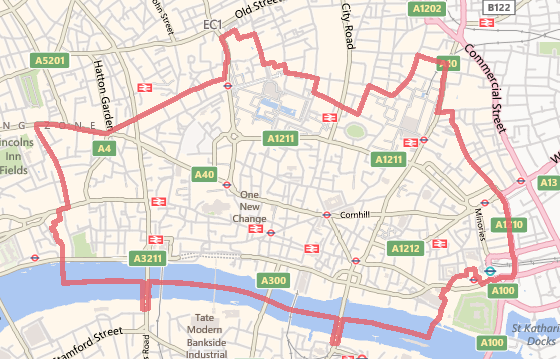
I’ve hiked the perimeter of several London boroughs, including – over an arduous six hours – Camden’s whopping 17 mile circumference.
History surely dictates, however, that the capital’s origin be attempted. Not just a mere borough, it’s actually the smallest UK county (since 1132), the second smallest British city in population and size (after St David’s in Wales) and, most famously, the richest square mile in the world.
Even better, from Kentish Town it’s only a few minutes’ train ride to our starting point, near Farringdon station.
1. Wander CHANCERY LANE

2. Admire GOLDEN LANE

3. Snake round MOORGATE

4. Ponder BISHOPSGATE
But on Moor Lane our quietude is slashed by the hypertrophy of civilisation: the whir of cranes, yells of builders, roar of trucks, and the scrape of metallic barriers, like fingernails on a blackboard. Is the City saying ‘enough’? We crane our necks at a towerblock, its windows like gills.

There’s a real sense of the old City wall as we snake around Middlesex Street, Widegate Street, Goodman’s Yard. London Wall was built by the Romans in the late 2nd century but has largely disappeared, whilst the current boundary has expanded over the years. Near the Tower of London (itself in the borough of Tower Hamlets) we spy two surviving sections (the others are near the Museum of London and St Alphage).
5. Stand still on LONDON BRIDGE


I had not thought death had undone so many.
Sighs, short and infrequent, were exhaled,
And each man fixed his eyes before his feet.
Oscar Wilde was blunter still: “To me the life of the businessman who…catches a train for the city…is worse than the life of the galley slave. His chains are golden instead of iron.”
We make one diversion away from the perimeter up to the City’s only Hawksmoor church, the elegant St Mary Woolnoth, built in 1716 from the proceeds of coal tax. As trains rumble deep into the clay beneath its foundations, its belfry rises like the prow of a boat.

We’re back at Chancery Lane three hours after our start and, about to dive into the cavernous Cittie of Yorke pub, glance over at the cranes perched like question marks over the City’s prosperity.
There’s no question about walking home, however, and we’ve soon left the oddly other-worldly environs of the UK’s smallest county – and are on the magic train straight back to NW5.


